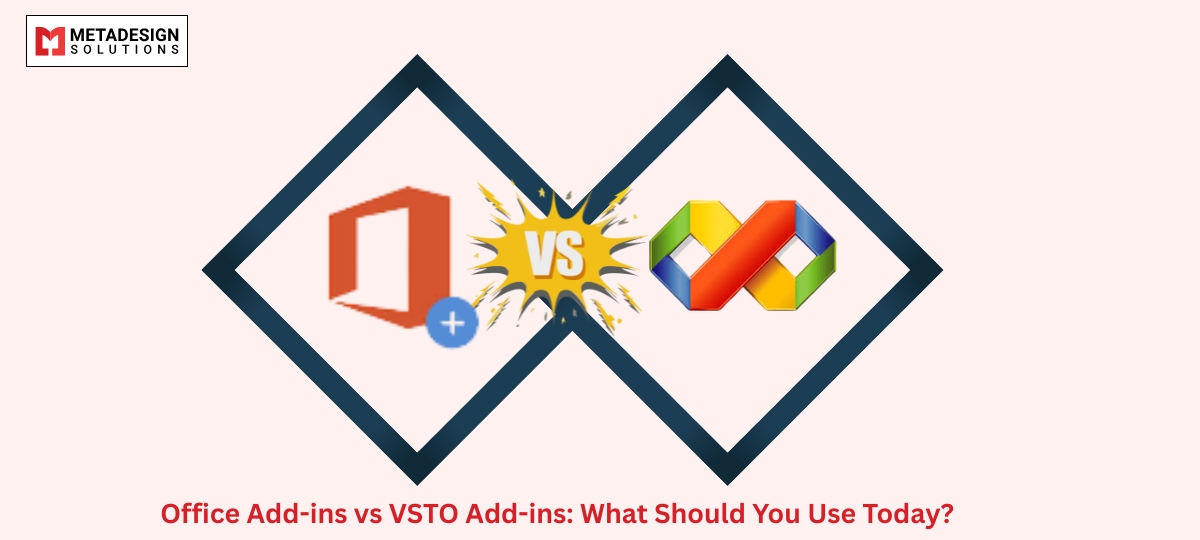When extending Microsoft Office applications, developers have traditionally relied on VSTO (Visual Studio Tools for Office) Add-ins. However, with the evolution of Office and the rise of cross-platform requirements, Office Add-ins have emerged as a modern alternative. This article delves into the distinctions between VSTO Add-ins and Office Add-ins, guiding you on which to choose based on current development trends and application needs.
Understanding VSTO Add-ins
VSTO Add-ins are developed using the .NET Framework, primarily with languages like C# or VB.NET. They run within the Office application’s process, allowing deep integration and access to the application’s object model. This enables developers to create feature-rich extensions that can manipulate documents, add custom UI elements, and automate tasks.
By leveraging VSTO Add-in Development Services, businesses can enhance the functionality of Office applications, streamline workflows, and boost productivity with custom solutions tailored to their needs. These services provide robust capabilities for integrating advanced features into Microsoft Office, including custom task panes, ribbon controls, and data manipulation — all aimed at maximizing the efficiency and effectiveness of your business operations.
Understanding Office Add-ins
Office Add-ins, also known as Office Web Add-ins, are built using standard web technologies such as HTML, CSS, and JavaScript. They operate within a browser-like environment embedded in the Office application, making them platform-independent and accessible across Windows, Mac, iPad, and Office Online. These add-ins interact with Office documents through the Office JavaScript API.
Choose the Right Add-in Strategy for Your Business
Unsure whether to opt for VSTO or Office Add-ins? Schedule a consultation with MDS to determine the best approach tailored to your needs.
Key Differences Between VSTO and Office Add-ins
| Aspect | VSTO Add-ins | Office Add-ins |
| Development Language | .NET languages (C#, VB.NET) | Web technologies (HTML, CSS, JavaScript) |
| Platform Compatibility | Windows only | Cross-platform (Windows, Mac, iPad, Office Online) |
| Deployment | Requires local installation and registry modifications | Web-based deployment; can be centrally managed and deployed via AppSource or organizational catalogs |
| Performance Impact | Runs within the Office process, potentially affecting performance | Runs in a separate process, minimizing impact on Office application performance |
| Access to Office Object Model | Full access to Office’s object model | Limited access through Office JavaScript API |
| Security | Relies on .NET security model; potential vulnerabilities due to deep integration | Sandboxed environment; restricted access enhances security |
| Maintenance and Updates | Requires manual updates on client machines | Centralized updates; users always access the latest version |
| User Experience | Seamless integration with Office UI; can create custom ribbons and task panes | Embedded in Office UI; customization options are more limited |
Pros and Cons of VSTO Add-ins
Pros:- Deep Integration: Full access to the Office object model allows for comprehensive customization and automation.
- Rich UI Customization: Ability to create custom ribbons, task panes, and form regions.
- Offline Functionality: Operates without requiring an internet connection.
- Platform Limitation: Restricted to Windows environments.
- Complex Deployment: Requires local installation with potential registry changes, complicating deployment and updates.
- Performance Impact: Shares resources with the Office application, which can lead to performance degradation.
- Security Concerns: Deep integration poses potential security risks if not managed properly.
Pros and Cons of Office Add-ins
Pros:- Cross-Platform Compatibility: Accessible on various platforms, including Windows, Mac, iPad, and Office Online.
- Simplified Deployment: Centralized deployment and updates through AppSource or organizational catalogs.
- Enhanced Security: Runs in a sandboxed environment, reducing security vulnerabilities.
- Modern Development Stack: Utilizes standard web technologies, allowing a broader range of developers to contribute.
- Limited Access to Object Model: Restricted interaction with the Office object model compared to VSTO.
- Dependence on Internet Connectivity: While some functionality may be available offline, optimal performance typically requires an internet connection.
- UI Customization Constraints: Customization options are more limited compared to VSTO Add-ins.
Choosing Between VSTO and Office Add-ins
When deciding between VSTO and Office Add-ins, consider the following factors:- Target Audience and Platforms: If your user base operates across multiple platforms, Office Add-ins offer broader compatibility.
- Functionality Requirements: For deep integration and extensive manipulation of Office applications, VSTO may be more suitable.
- Deployment and Maintenance: Office Add-ins provide easier deployment and centralized updates, reducing IT overhead.
- Performance Considerations: Office Add-ins run in a separate process, minimizing the risk of impacting Office application performance.
- Development Expertise: Leverage your team’s existing skills; .NET developers may prefer VSTO, while web developers might opt for Office Add-ins.
Transitioning from VSTO to Office Add-ins
For organizations with existing VSTO Add-ins looking to transition to Office Add-ins, consider the following steps:- Assess Current Functionality: Identify features that can be replicated within the Office Add-ins framework and those that may require rethinking due to API limitations.
- Migrate in Phases: Avoid a complete rewrite at once. Identify smaller modules of functionality from your existing VSTO add-in that can be independently rebuilt using Office JavaScript APIs.
- Re-evaluate UI/UX: Office Add-ins have a different user interface model. Use Fluent UI (formerly Office UI Fabric) to maintain a modern, responsive, and consistent design experience within the Office ecosystem.
- Integrate Microsoft Graph: Since Office Add-ins can’t access the full COM object model like VSTO, consider using Microsoft Graph API to connect with Outlook emails, calendar events, contacts, and OneDrive documents.
- Authentication Strategy: Use Microsoft Authentication Library (MSAL.js) to authenticate users securely and access Microsoft Graph data within your add-in.
- Use Feature Flags and Fallbacks: For hybrid environments, use feature detection and version control to ensure that users on legacy Office versions still have access to VSTO functionality, while others can use the new Office Add-in experience.
🔍 Real-World Use Case: Migrating an Outlook VSTO Add-in to Office Add-in
Scenario: A law firm uses a VSTO Outlook add-in to archive emails to a local document management system (DMS).Challenges:- The VSTO add-in relies heavily on local file access and Outlook’s full object model.
- Deployment is manual and error-prone.
- It only works on Windows.
- Replace local storage with OneDrive for Business or SharePoint Online.
- Use Office.js to access the currently selected email.
- Integrate Graph API to save attachments or metadata to cloud storage.
- Provide a task pane UI using React + Fluent UI.
- Deploy the add-in organization-wide via Centralized Deployment.
- Works on Outlook for Windows, Mac, Web, and Mobile.
- Centralized updates with no user-side installations.
- Better security posture (sandboxed environment).
- Easier collaboration and document sharing.
✅ Summary: VSTO Add-ins vs Office Add-ins – Feature Comparison Table
| Feature | VSTO Add-ins | Office Add-ins |
| Language Support | C#, VB.NET (.NET Framework) | JavaScript, TypeScript, HTML, CSS |
| Platform Support | Windows Desktop Office only | Cross-platform (Windows, Mac, Web) |
| UI Integration | Deep (custom ribbons, forms) | Task panes, command ribbons |
| Object Model Access | Full COM object model | Limited JavaScript API |
| Offline Support | Full offline capability | Limited (some APIs require online) |
| Deployment | Manual or via MSI | Centralized or via AppSource |
| Modern Dev Stack | Limited | Full modern web development stack |
| Security & Sandboxing | Less secure | More secure (sandboxed) |
| Microsoft 365 Compatibility | Partial | Full (Graph, SSO, Teams, etc.) |
| Maintenance | Complex (requires IT involvement) | Easy and remote updates |
🧠 When Should You Use Each?
Use VSTO Add-ins if:
- You need deep integration with Office’s COM object model
- Your application is Windows-only
- You require extensive offline support
- Your team has legacy .NET experience and infrastructure
Use Office Add-ins if:
- You want a cross-platform solution (Windows, Mac, Web, Mobile)
- You want cloud-native and modern app development
- You’re leveraging Microsoft 365, Graph API, or Azure services
- You want to distribute and maintain add-ins centrally and securely
🏁 Conclusion
In 2025, Office Add-ins are the recommended and future-proof way to extend Microsoft Office applications. While VSTO Add-ins still serve important legacy roles—especially for Windows-only, offline-heavy applications—their limitations in deployment, platform support, and modernization make them increasingly outdated.On the other hand, Office Add-ins, built with JavaScript, HTML, and CSS, provide:- Seamless cross-platform compatibility
- Integration with cloud services (Microsoft Graph, Azure)
- Simplified and centralized deployment
- Improved user experiences across devices and platforms
Related Hashtags:
#MicrosoftGraph #OfficeAddins #AzureOpenAI #Microsoft365Development #OfficePlugin #GraphAPI #OfficeAddinDev #IntelligentApps #CopilotIntegration #OpenAI #WordAddin #OutlookAddin #ExcelAutomation #SSOAuth #NextGenProductivity #MicrosoftGraphAPI #Microsoft365Copilot #OfficeDev #AIinOffice #GPTinOffice



